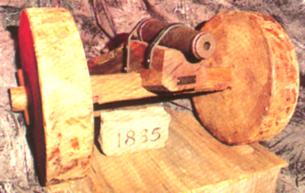Fate of the Gonzales Cannonhttp://www.sonsofdewittcolony.org/gonzalescannon.htmLike all artifacts, documents, historic sources and views on Texas history, particularly those with especially significant symbolic value, the fate of the Gonzales Cannon is a source of controversy.

Dr. Patrick Wagner, historian and gun collector, summarized his view in an article from The History of Gonzales County, Texas. In preparation for the confrontation at Gonzales he relates that
"On October 1 John Sowell, Jacob Darst and Richard Chisholm exhumed the Peach Orchard Cannon and mounted it on the axle of Eli Mitchell's cotton wagon. Darst unspiked the touchhole leaving it somewhat oversized, about that of a man's thumb."
He further describes his view of the fate of the cannon after the confrontation:
"The following day, October 3, 1835, Noah Smithwick (see Evolution of a State, ch. VII), a skilled blacksmith and gunsmith arrived at Gonzales and received reports of the battle and noted how the wallowed-out touchhole had backfired smoke and powder during the battle. He took the rusty iron cannon back to Sowell's blacksmith shop to repair the touch-hole. He heated the weapon and poured molten metal in the oversized touch-hole. Hardening it with water, a crude nail bit was used to bore a new hole in the molten plug. That threw the ignition fire too far to the rear of the breech, so he spiked the new touch-hole with more molten metal. A second new touch-hole was then bored ahead of the first, but it was too small to sustain the fire powder with enough oxygen to discharge the cannon. The second touch-hole was plugged with molten metal and with plow-shearing and the point of a file, he center-punched the adjacent breech metal and the original spiked touch-hole. About fifteen degrees from the spike he bored a new and efficient touch-hole, brushed the cannon and mounted it on wooden trucks (wheels) cut from trunks of cottonwood trees found near the river bottom. To further magnify the cannon, a limber was attached to the trail of the cannon and the new carriage and limber were christened the 'Flying Artillery' it bounced out of Gonzales on October 12 enroute to Bejar."
"According to Smithwick, about a day's march out of Gonzales, the axle and wheels began to smoke because of friction in spite of pouring water on it and using tallow as an axle lubricant. Two pair of longhorn steers had to be prodded with forty homemade file-pikes, which had been made by Chisholm and attached to cane poles. The file-pikes were the first and only uniform accouterments of the First Voluntary Army and their purpose was for use against the Mexican Cavalry. After the 'army' crossed Sandies Creek and went about one and one-half miles west they camped in a circular fashion around a mound on the west bank of the Sandies. On the morning of October 14, General Stephen F. Austin and Colonel Ben Milam inspected the broken carriage of the Flying Artillery, realized the ineffectiveness of the runty cannon and decided to abandon it. So, the cannon was buried in a shallow, sandy grave below its carriage which was set on fire to give the appearance of an Indian campfire. Creed Taylor reported that he last saw the cannon flag alongside a sapling near the cannon's grave."
More at link above.
I can't tell what the bore of the cannon is. It can't be much larger than my 1" bore cannon.